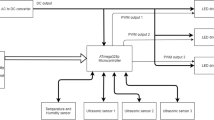Abstract
Purpose
Today’s highly technical operating rooms lead to fairly complex surgical workflows where the surgeon has to interact with a number of devices, including the operating room light. Hence, ideally, the surgeon could direct the light without major disruption of his work. We studied whether a gesture tracking–based control of an automated operating room light is feasible.
Methods
So far, there has been little research on control approaches for operating lights. We have implemented an exemplary setup to mimic an automated light controlled by a gesture tracking system. The setup includes a articulated arm to position the light source and an off-the-shelf RGBD camera to detect the user interaction. We assessed the tracking performance using a robot-mounted hand phantom and ran a number of tests with 18 volunteers to evaluate the potential of touch-less light control.
Results
All test persons were comfortable with using the gesture-based system and quickly learned how to move a light spot on flat surface. The hand tracking error is direction-dependent and in the range of several centimeters, with a standard deviation of less than 1 mm and up to 3.5 mm orthogonal and parallel to the finger orientation, respectively. However, the subjects had no problems following even more complex paths with a width of less than 10 cm. The average speed was 0.15 m/s, and even initially slow subjects improved over time. Gestures to initiate control can be performed in approximately 2 s. Two-thirds of the subjects considered gesture control to be simple, and a majority considered it to be rather efficient.
Conclusions
Implementation of an automated operating room light and touch-less control using an RGBD camera for gesture tracking is feasible. The remaining tracking error does not affect smooth control, and the use of the system is intuitive even for inexperienced users.
Similar content being viewed by others
References
Knulst AJ, Mooijweer R, Jansen FW, Stassen LP, Dankelman J (2011) Indicating shortcomings in surgical lighting systems. Minim Invasive Ther Allied Technol 20(5): 267–275
Matern U, Koneczny S (2007) Safety, hazards and ergonomics in the operating room. Surg Endosc 21(11): 1965–1969
Koneczny S (2009) The operating room:architectural conditions and potential hazards. Work 33(2): 145–164
Knulst AJ, Mooijweer R, Dankelman J (2012) A simulation model that predicts handling forces required to reposition surgical lights. J Med Eng Technol 36(3): 174–179
Patkin M (2003) What surgeons want in operating rooms. Minim Invasive Ther Allied Technol 12(6): 256–262
Nollert G, Wich S (2009) Planning a cardiovascular hybrid operating room: the technical point of view. Heart Surg Forum 12(3): E125–E130
Kpodonu J (2010) Hybrid cardiovascular suite: the operating room of the future. J Card Surg 25(6): 704–709
Zoon WAC, van der Heijden MGM, Loomans MGLC, Hensen JLM (2010) On the applicability of the laminar flow index when selecting surgical lighting. Build Environ 45(9): 1976–1983
Reilink R, de Bruin G, Franken M, Mariani MA, Misra S, Stramigioli S (2010) Endoscopic camera control by head movements for thoracic surgery. In: Proceedings of the 3rd IEEE RAS & EMBS international conference on biomedical robotics and biomechatronics, Tokyo, pp 510–515
Noonan DP, Mylonas GP, Shang J, Payne CJ, Darzi A, Yang GZ (2010) Gaze contingent control for an articulated mechatronic laparoscope. In: Proceedings of the 3rd IEEE RAS & EMBS international conference on biomedical robotics and biomechatronics, Tokyo, pp 759–765
Finke M, Stender B, Bruder R, Schlaefer A, Schweikard A (2010) An experimental comparison of control devices for automatic movements of a surgical microscope. In: Proceedings of the 24th international conference and exhibition on computer assisted radiology and surgery, pp 311–312
Hiltl C, Omid A, Schrader S (2011) Control system and method to operate an operating room lamp. US2011037840
Kusner M, Centanni MA (2010) Method and apparatus for electronic adjustment of illuminance of surgical lamp. US20100121154
Laerum F, Fosse E, Elle OJ (2003) Light system for use especially by operating theatre. US2003146719
Wachs JP, Stern HI, Edan Y, Gillam M, Handler J, Feied C, Smith M (2008) A Gesture-based tool for sterile browsing of radiology images. J Am Med Inform Assoc 15(3): 321–323
Ebert LC, Hatch G, Ampanozi G, Thali MJ, Ross S (2011) You can’t touch this: touch-free navigation through radiological images. Surg Innov
Richter L, Ernst F, Martens V, Matthäus L, Schweikard A (2010) Client/server framework for robot control in medical assistance systems. In: Proceedings of the 24th international congress an exhibition on computer assisted radiology and surgery, Geneva, pp 306—307
OpenNI organization (2012) OpenNI documentation. http://openni.org/Documentation. Accessed 04 April 2012
Primesense Inc (2011) Prime sensor(TM) development kit RD1.081 user guide
Silicon Graphic Inc (2011) OpenGL 2.1 reference pages, glulookat—define a viewing transformation. http://www.opengl.org/sdk/docs/man/xhtml/gluLookAt.xml. Accessed 07 Jan 2012
LightOR. http://www.lightor.com. Accessed 03 April 2012
LightOR Video. http://www.lightor.com/images/flash/LightOR_web_wide.swf. Accessed 03 April 2012
Author information
Authors and Affiliations
Corresponding author
Electronic Supplementary Material
The Below is the Electronic Supplementary Material.
Rights and permissions
About this article
Cite this article
Hartmann, F., Schlaefer, A. Feasibility of touch-less control of operating room lights. Int J CARS 8, 259–268 (2013). https://doi.org/10.1007/s11548-012-0778-2
Received:
Accepted:
Published:
Issue Date:
DOI: https://doi.org/10.1007/s11548-012-0778-2




